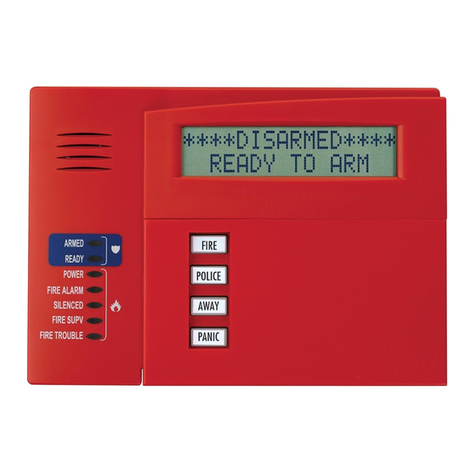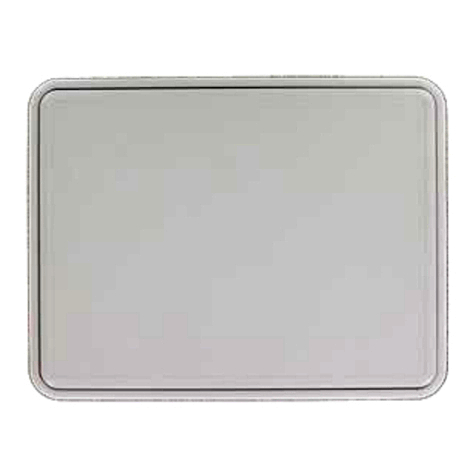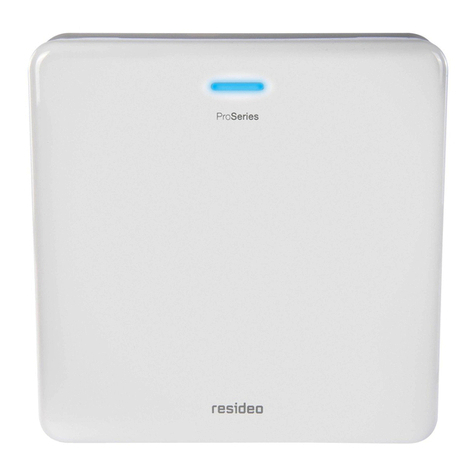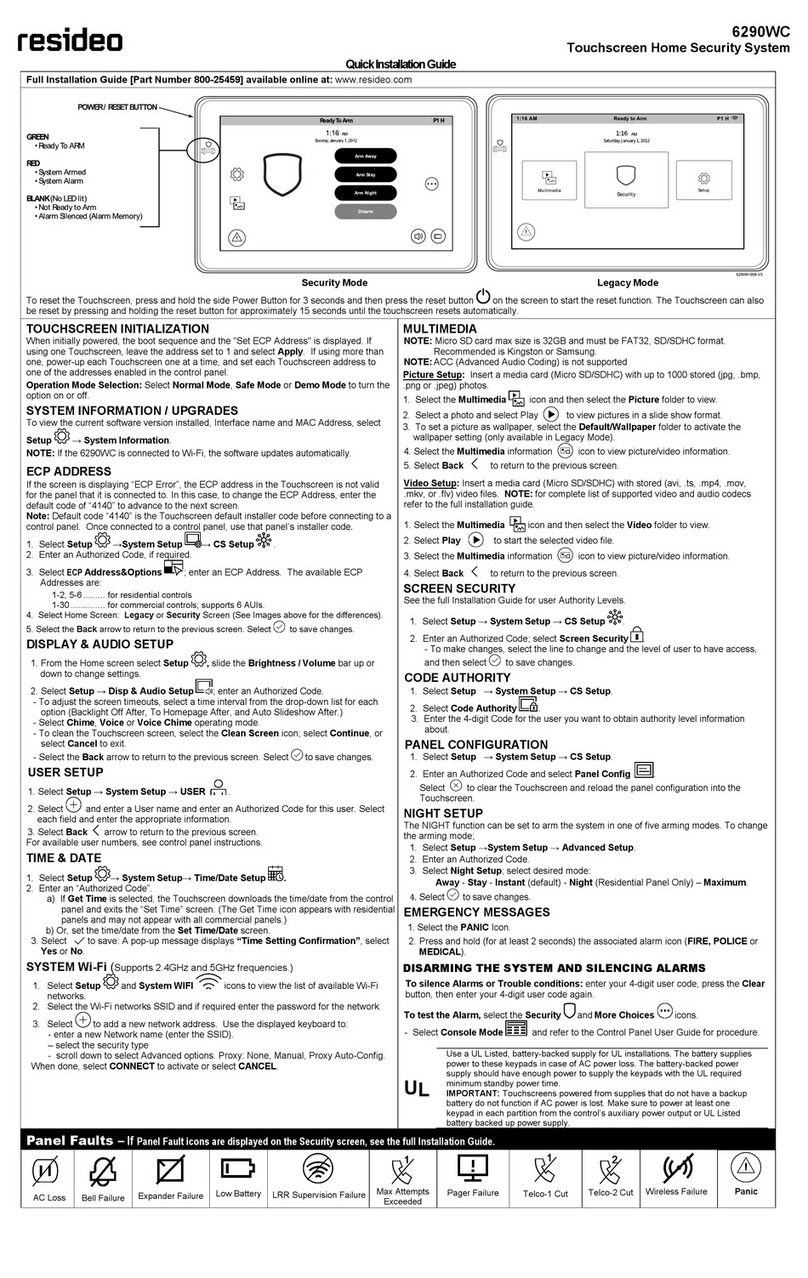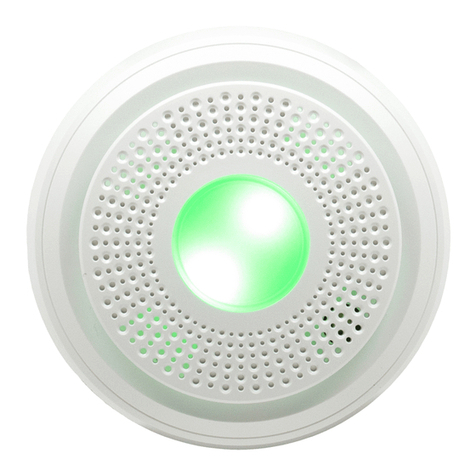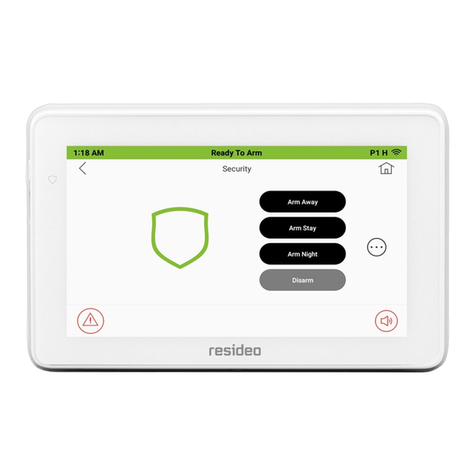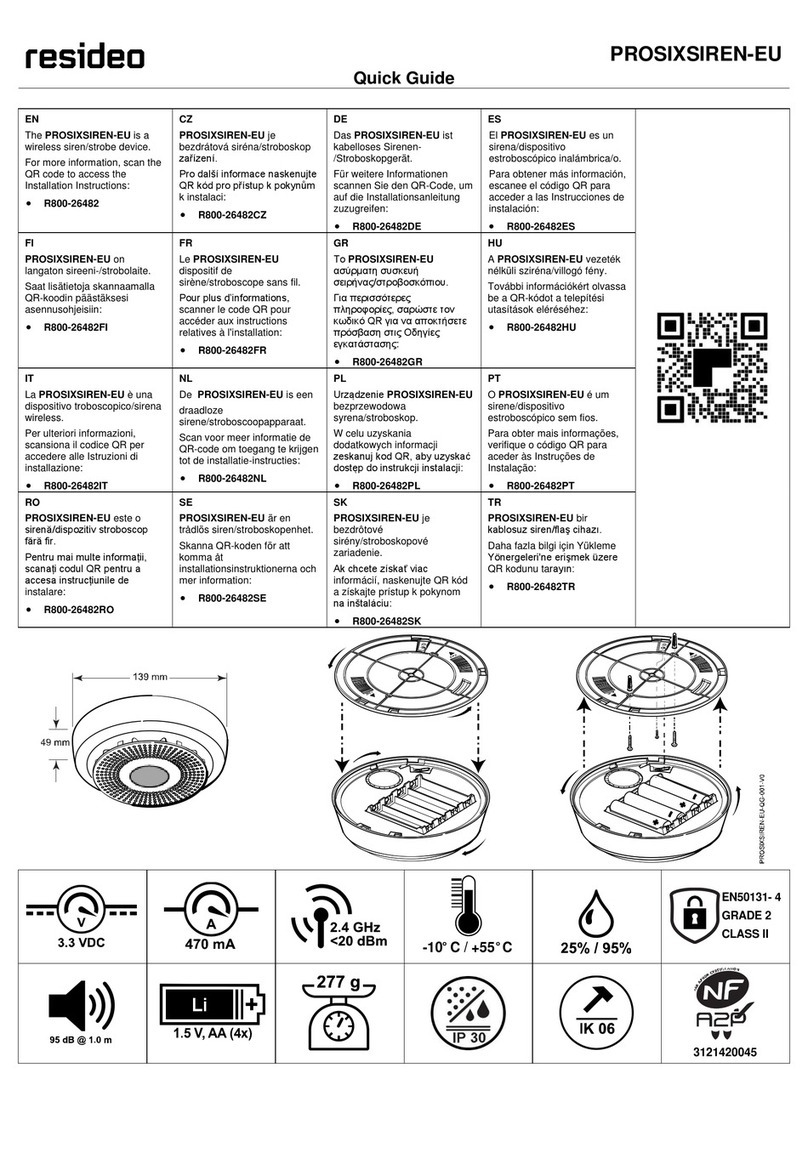
Ê800-11045QG-2C=Š
800-11045QG-2C 9/12 Rev CPart 1
The TEST key puts your system in Burglary Walk Test mode, which allows
each burglary protection point to be checked for proper operation. Testing
should be conducted weekly to ensure proper operation.
•The keypad sounds a single beep about every 30 seconds as a reminder
that the system is in the Test mode.
•Alarm messages are not sent to your Central Station while Test mode is on.
If a problem is experienced with any detection point (no confirming sounds, no
display), call for service immediately.
1. Disarm the system and close all protected windows, doors, etc. The
READY indicator light should come on if all zones are intact
2. Enter your 4-digit Master code + 5
3. Listen. The external sounder should sound for about 1 second then turn off.
If the sounder does not sound, CALL FOR SERVICE. The "Burg Walk Test
Reduced RF Sens." display appears only on the keypad that started the
test.
4. Fault zones. Open each protected door and window in turn and listen for
three beeps from the keypad. Each faulted detection point should appear
on the display. The display clears when the door or window is closed.
5. Walk in front of any interior motion detectors (if used) and listen for three
beeps. Each detector should appear on the display when it is activated. The
display clears when no motion is detected. Note that if wireless motion
detectors are used, there is a 3-minute delay between activations to
conserve battery life.
6. When all detection points have been checked and are intact (closed), there
should be no zone numbers displayed.
7. Exit test mode: 4-digit code + 1
TROUBLE CONDITIONS
The word CHECK or TRBL on the keypad's display, accompanied by a rapid
"beeping" at the keypad, indicates a trouble condition in the system.
To silence the beeping for these conditions, press a valid code + 1.
Typical Trouble conditions include the following:
“Open Circuit Call for Service" indicates a problem exists with your keypad
connection to the Control panel. CALL FOR SERVICE IMMEDIATELY.
“CHECK” or “TRBL" display accompanied by a display of one or more zone
descriptors indicate that a problem exists with those zone(s). First, determine if
the zone(s) displayed are intact (this may include Fire and Waterflow type
zones) and make them so if they are not. If the problem has been corrected,
key an OFF sequence (Code plus OFF) to clear the display. If the display
persists, CALL FOR SERVICE IMMEDIATELY.
“CHECK” or “TRBL” display accompanied by a display of “6XX,” where XX =
01-32, indicates a trouble on a supervised relay (corresponding relay number
01-32).
“CHECK” or “TRBL” display accompanied by a display of “8XX,” where XX =
00-30, indicates a trouble on a peripheral device (connected to the panel’s
keypad terminals).
“CHECK” or “TRBL” display accompanied by a display of “9XX,” where XX =
00-
99, indicates a system trouble exists (dialers, Notification Appliance
Circuits, ground fault, etc.). These zones are as follows:
988: 2nd RF Receiver – not receiving signals
990: 1st RF Receiver – not receiving signals
“SUPV” display accompanied by a display of one or more zone descriptors
indicates a problem on fire supervisory zone(s). This means that the operation
of the fire alarm system may be compromised. First, determine if the zone(s)
displayed are intact and make them so if they are not. If the problem has been
corrected, key an OFF sequence (Code plus OFF) to clear the “SUPV”
display. If the display persists, CALL FOR SERVICE IMMEDIATELY.
A display of "COMM. FAILURE" at the Keypad indicates that a failure has
occurred in the telephone communication portion of your system. CALL FOR
SERVICE IMMEDIATELY.
A display of "SYSTEM LO BAT", accompanied by a rapid "beeping" at the
Keypad indicates th
at a low system battery condition exists. CALL FOR
SERVICE IMMEDIATELY.
A display of "LO BAT" and a zone descriptor, accompanied by a once per
minute "beeping" at the Keypad indicates that a low battery condition exists in
the wireless transmitter displayed. CALL FOR SERVICE IMMEDIATELY.
A display of "MODEM COMM"indicates that the control is on-line with the
central station's remote computer. The control will not operate while on-line.
A display of “HSENS”and a zone number indicates a smoke detector with a
high sensitivity level, which may cause false alarms. CALL FOR SERVICE
IMMEDIATELY.
A display of “LSENS”and a zone number indicates a smoke detector with a
low sensitivity level. Detectors with a low sensitivity might not detect a smoke
condition. CALL FOR SERVICE IMMEDIATELY.
Power Failure
If the message "AC LOSS" is displayed, the Keypad is operating on battery
power only. If only some lights are out on the premises, check circuit breakers
and fuses and reset or replace as necessary.
IMMEDIATELY if AC power cannot be restored.
SETTING THE DATE AND TIME
NOTE: All partitions must be disarmed before date/time can be set. You can
set the time and date by doing the following:
1. +[#] + [6] [3]
(Master Code)
2. Press [∗] when the time/date is displayed.
A cursor appears under the first digit of the hour.
To move cursor to the right, press [∗]. To move the cursor to the left, press
[#].
•Enter the correct hour setting, then press [∗].
•Enter the correct minute setting, then press [∗].
•Press any key [0] – [9] to change AM to PM, or PM to AM, then press [∗].
•Enter the correct month using a 2-digit setting, then press [∗].
•Enter the correct day using a 2-digit setting, then press [∗].
•Enter the current year, then press [∗].
3. Press [∗] to exit the Real Time Clock Edit Mode.
SERVICING INFORMATION
Your local Resideo dealer is the person best qualified to service your alarm
system. Arranging some kind of regular service program with him is
advisable. Your local Resideo dealer is:
Name:
Address:
Phone:
This product is manufactured by Resideo and its affiliates.
2 Corporate Center Drive, Suite 100
P.O. Box 9040, Melville, NY 11747
2020 Resideo Technologies, Inc.
www.resideo.com
VISTA TURBO FIRE SERIES
Vista-32FBPT/Vista-128FBPT/Vista-250FBPT
Quick Guide to User Functions
Full User Guide Available Online: This Quick Guide describes the most frequently used features and functions of your system. For
full details of all user functions, please see the system’s User Guide located online at: www.resideo.com. The full version User Guide
is also available from your installer upon request.
Congratulations on your ownership of a Resideo Security System. This system provides:
•Three forms of detection: burglary, fire and emergency (see your installer for which forms of detection are installed)
•At least one keypad which provides control of system and displays system status
•Various sensors for perimeter and interior burglary detection
•Smoke and/or combustion detectors designed to provide early warning in case of fire.
Your system may also be programmed to automatically send alarm and status messages to a Central Monitoring Station.
The following is a list of some of the most common features and functions of
your system:
•Several modes of burglary detection: Away, Stay, Instant, Maximum.
•Bypass feature lets authorized persons to bypass selected zones while
leaving the rest of the system armed.
•Chime mode alerts you to the opening of protected doors and windows
while the system is disarmed, if enabled.
•Fire and carbon monoxide detection are always active (if installed) and an
alarm sounds if a fire or carbon monoxide condition is detected.
•Panic keys (if programmed) let you manually initiate a fire and personal
alarms using the keypad.
•4-digit security codes are used in conjunction with keypad command to
perform system functions.
•Each user can be assigned a different security code, each with different
authority levels.
•The system sensing devices have been assigned to various “zones,” which
are specific areas of detection (e.g., front door, storage room window,
etc.).
•Zone numbers (points of detection) are displayed at the keypad when an
alarm or trouble condition occurs.
•Partitions provide two independent areas of detection with each partition
containing a group of zones that can be armed and disarmed without
affecting other zones.
•Function keys may have been programmed to perform various functions.
Ask your installer if these keys are active.
•A Scheduling feature can be programmed to automatically perform certain
functions (e.g., arm the system) at a predetermined time each day. See the
full User Guide for details.
ENTRY/EXIT DELAYS
•Entry Delays give you time to disarm the system when you enter through
the designated entrance door.
•You must disarm the system before the entry delay period ends, or an
alarm will occur (keypad beeps during the entry delay period, reminding
you to disarm the system).
•Exit delay gives you time after arming the system to leave through the
designated exit door(s) without setting off an alarm. If programmed, a slow
beeping will sound during the exit delay period until the last 10 seconds,
which then changes to fast beeping (alerting you to the end of exit delay).
If you cannot leave within this delay time period, you should stop, disarm
the system, and start over to avoid a false alarm.
See your installer for your delay times. See the full User Guide for details
NOTES on BURGLARY DETECTION
•The system must be armed before the burglary detection can sense
intrusions.
•To arm your system, enter your security code followed by the desired
arming key.
•To disarm the system, enter your security code then press the OFF key.
•When an alarm occurs, the keypad sounds and displays the zone(s)
causing the alarm. The external sounder may also sound.
•If your system is connected to a Central Monitoring Station, an alarm
message is also sent (may be delayed 30 seconds to reduce false
alarms).
•To stop the alarm sounding, simply disarm the system.
•Memory of Alarm: When an alarm condition occurs, the keypad
displays the number(s) of the zone(s) that caused the problem, and
displays the type of alarm. Clear the Memory of Alarm display by
entering another “off” sequence.
IMPORTANT: If you return to the premises and the main
burglary sounder is on, or the keypad beeps rapidly upon
entering the premises, it indicates that an alarm has oc-
curred during your absence and an intruder may still be on
the premises. LEAVE IMMEDIATELY and CONTACT THE
POLICE from a nearby safe location.
NOTES on FIRE and CO DETECTION
•Your fire alarm system (if installed) is on 24 hours a day, for continuous
detection. In the event of an emergency, the smoke and heat detectors
sound their alarms, triggering a loud, interrupted pulsed sound from the
Keypad(s) and any external sounders.
•You can silence the alarm at any time by pressing a valid code + OFF.
•Carbon monoxide (CO) detectors, if installed, provide continuous
detection. If a high level of carbon monoxide is detected, an interrupted
pulsed alarm sound occurs at the keypads and the detector(s).
Immediately move to a spot where fresh air is available, preferably
outdoors. From a safe area, call your security service provider for
further instructions. To silence the keypad sounding, press a valid code
+ OFF. To silence the detector, see its instructions.

